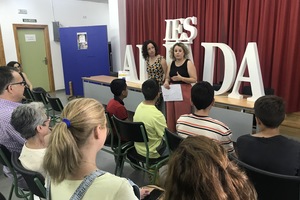Educators in IES La Aljada (Puente Tocinos, Murcia, Spain) discuss Project BEST

Between March and May 2022, through the project "BEST, Build European Solidarity Today:
Let's replay the Fraternity Card!", co-funded by the EU Erasmus+ programme and coordinated by the CIVES Foundation in Spain, thousands of students from various educational centers across Spain sent postcards to random recipients with the aim of sharing messages of solidarity and fraternity.
Two educators from the RIEI programme (Integral Network of Intercultural Spaces) of Liga Española de la Educación discussed their experience carrying out Project BEST in La Aljada secondary school of Puente Tocinos (Murcia, Spain). The educators conducted the project with all the students of the 1st ESO (compulsory secondary school; 11-12 years). One of the educators explains that they started the sessions by discussing the images on the postcards. “A small debate was created in which they were asked about what they thought was happening in each image and what feelings and emotions were aroused when they saw them. After this small debate, they were shown the photographer's vision of his own image.
” After this, students discussed how the photographer's vision contrasted with their original perception of the image. Then, before writing the messages on the postcards, the students completed a writing activity where the educators guided them on how to write solidarity messages. Finally, the students wrote the postcards which were then sent to their recipients (among them, the president of the national government).
In order to integrate all the BEST images and stay faithful to the goal of fostering intercultural education, the educators broadened the theme of the project to all forms of diversity and discrimination. However, to mark that the activity was conducted on March 21, the International
Day for the Elimination of Racial Discrimination, they placed special emphasis on a postcard with an image that reflected racial discrimination, a photo that showed migrants in Spain being approached and asked for documentation by the National Police due to their skin color and
lower socioeconomic status.
One educator spoke about two memorable experiences that stuck out to her when conducting the activity. She said that one photograph, reflecting a boy who committed suicide because he had been bullied for his sexual orientation, led a boy in the class to speak up. “There was a boy who was moved when we told him the story of the photograph, and he dared to tell his own story. He had been bullied and had even tried to commit suicide because he did not accept his own sexual condition, as he was a transgender boy. The response from the class was very nice and very welcoming. The boy said it was the first time he dared to express himself like that. And the truth is that it was quite a moving moment.”
The solidarity, empathy, and compassion the students showed for situations, people and injustices around the world are what the educators feel has been the biggest impact of the project. They also feel that due to the passion students felt towards the images, they were
encouraged to participate more than they usually would. “We believe that there was a very positive impact and that it sowed a seed to start to put aside the hatred we have towards those who are different just because they are different, and that they can become citizens who show
more solidarity and respect for those who are different and unknown.”